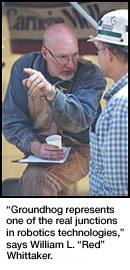Carnegie Mellon's Groundhog, an autonomous, four-wheeled robot with huge heavy duty tires, took an unprecedented trip into an abandoned coal mine in late May and was able to create accurate three-dimensional maps of its surroundings.
Students in the Robotics Institute's Mobile Robot Development class, taught by Systems Scientist Scott Thayer and Fredkin University Professor William L. "Red" Whittaker, developed the robot in response to an incident at the Quecreek Mine near Somerset, Pa. last July, when nine miners nearly drowned after they accidentally breached the wall of an adjacent flooded mine. Inaccurate maps were cited as a cause of the accident.
 Groundhog's goal was to explore and map a 3,500-foot corridor of an abandoned coal mine near New Eagle in southwestern Pennsylvania. Overseeing the excursion were the Carnegie Mellon control team and officials from the Pennsylvania Department of Environmental Protection (DEP) and the U.S. Department of Labor's Mine Safety and Health Administration (MSHA).
Groundhog's goal was to explore and map a 3,500-foot corridor of an abandoned coal mine near New Eagle in southwestern Pennsylvania. Overseeing the excursion were the Carnegie Mellon control team and officials from the Pennsylvania Department of Environmental Protection (DEP) and the U.S. Department of Labor's Mine Safety and Health Administration (MSHA).
The robot entered the mine from a portal near its supply yard and traveled slowly into the mine at a speed of 1 mile per hour. About 1,000 feet into the mine, Groundhog, which sends its robot-eye view back to the control team through a wireless video system, encountered a fallen ceiling beam that crossed its path. It made the appropriate decision to retreat.
During its retreat, Groundhog had to reboot its computer system several times for reasons still unknown. Two safety officers from the DEP entered the mine to reset the robot's data transceiver. The robot's control team then reestablished communication and guided the robot out of the mine and back to its control truck under the robot's own power.
"The level of autonomy necessary to achieve this mission was remarkable," said Associate Computer Science Professor Sebastian Thrun, who contributed his site localization and mapping technology to the project.
�
�
More...



